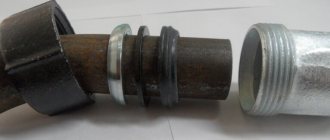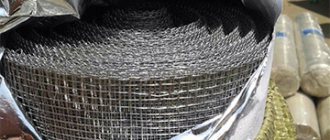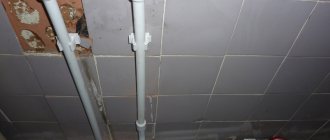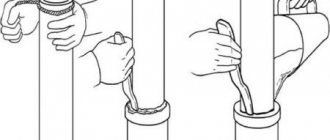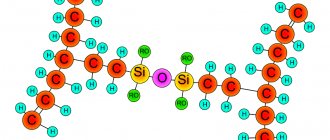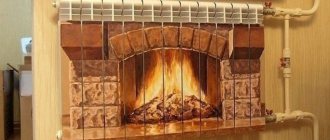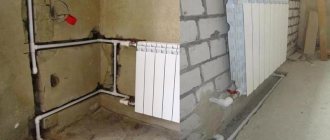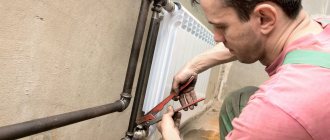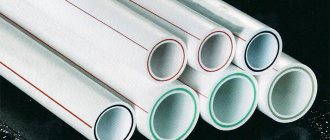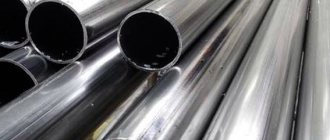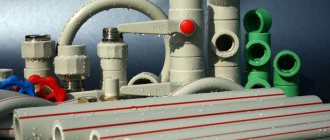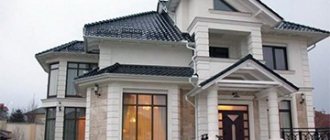Installation of steel heating pipes - advantages and disadvantages, characteristics
Despite the abundance of all kinds of pipe products on the modern construction market, steel pipes still have not lost their importance and are used in a number of areas. This also applies to the installation of space heating systems, where, despite the dominance of pipes made of polymer materials, the “classic” version with steel heating pipes is still sometimes used.
Advantages and disadvantages of steel heating pipes
Steel pipes for arranging heating systems have some advantages, the main ones are the following:
- strength and resistance to mechanical loads;
- ability to withstand very high temperatures;
- resistance to high pressure inside pipes;
- ease of heating when the water inside freezes;
- affordable price.
As for the shortcomings, they also exist, in particular:
- difficulty in installing steel heating pipes;
- the difficulty of laying in places where it is necessary to give the pipeline a non-standard shape;
- the need for additional thermal insulation (due to the high thermal conductivity of steel);
- susceptibility to corrosive processes;
- relatively short service life of approximately 15 years.
In general, steel pipes are inferior in a number of technical characteristics to pipe products made of various polymers, for example polypropylene, metal-plastic, pipes made of cross-linked polyethylene, etc. To eliminate some of these disadvantages, various technological methods are used during installation work. For example, if the length from the heating source to the heating radiator is large enough, then they are carefully insulated to avoid heat losses along the path of the pipes.
If it is necessary to give steel pipes anti-corrosion resistance, then they resort to the process of galvanizing them. This method is used quite often, as a result of which it should be discussed in more detail.
Galvanization of steel pipes for heating and properties of galvanized pipes
The galvanizing method is often used when installing metal heating pipes, not only steel, but also cast iron and some others. In this case, the pipes are coated with a layer of zinc to prevent them from corroding under the influence of water, air or moisture.
When exposed to oxidation, zinc quickly becomes covered with an oxide film, which protects it from further chemical interactions. As a result, galvanized steel becomes resistant to processes that cause corrosion.
Galvanizing can be done in two ways: diffusion or hot. The first method is carried out at a temperature of approximately 400 °C. In this case, powdered zinc is used, the atoms of which penetrate through diffusion into the intercrystalline structure of the steel pipe. This contributes to the formation of a very strong and stable connection.
As for the hot-dip galvanizing method, the entire steel pipe is immersed in molten zinc at a temperature of 450 °C.
Through the galvanizing process, steel pipes receive anti-corrosion and electrochemical protection. A heating system equipped with such pipes can last much longer and more efficiently, but its disadvantage will be the inability to use antifreeze against freezing. However, galvanized pipes are considered much more practical and reliable in operation than conventional steel pipes.
Installation of steel heating pipelines
The process of installing heating pipes from steel pipes can be carried out in two ways: threaded and welded. Both methods are quite reliable, but quite complex from a technological point of view, and therefore require the involvement of professionals to implement them.
When connecting steel pipes by means of threaded twisting, threads must first be cut into the ends of the joined products, after which they are connected to each other using couplings, fittings, bends and other intermediate products, the quality of which must be given special attention.
The use of winding is mandatory for a threaded connection. For this purpose, it is better to use fum tape or plumbing polymer thread. Linen winding can be used for stainless steel pipes.
For ordinary steel pipes, flax is not recommended as a winding material, since constant moisture at the threaded connection can lead to corrosion.
The connection method by welding is even more reliable, however, unlike threaded connections, it is permanent, that is, disassembling the connection if necessary becomes impossible.
The process of welding steel pipes can only be carried out by qualified specialists. This work requires special welding equipment, the operation of which is significant and inaccessible to those who do not have professional skills.
In general, when carrying out welding work, you must adhere to the following important rules:
- Installation of heating using steel pipes should begin with the installation of a riser; and then it is from the side of the riser that the pipeline should be laid. However, in most cases, work in residential buildings is not carried out from scratch, but comes down to replacing outdated heating communications. Therefore, depending on the situation, the welding process may have certain features.
- Galvanized steel pipes are welded using self-shielding wire with a diameter of about 1 millimeter. In some cases, it is possible to use electrodes with a diameter of up to 3 millimeters, having a rutile or calcium fluoride coating.
- The connection of non-galvanized steel pipes for heating, which at home usually have a diameter of no more than 25 millimeters, is most often made with an overlap. The assembly of such pipelines by butt welding is carried out only at enterprises.
- The weld seam when connecting steel pipes must be smooth in relation to the surface of the products being connected, and not have sagging, cracks or other defects and flaws (read: “Options for welding galvanized pipes - advantages and disadvantages of methods”).
Installation features: general principles
The first thing you should pay attention to during installation is the amount of work expected. It is advisable to have a drawn up plan diagram in hand and decide on the choice of material. Based on pre-made measurements, the exact length of each pipe is indicated on the diagram, thereby avoiding additional costs.
Typically, either a reciprocating saw or a pipe cutter is used to cut pipes. Both methods are used in specific situations:
- The pipe cutter uses special cutting discs. They become dull over time and have to be replaced.
- Separate discs were invented for stainless steel pipes, which are sharpened using improved technology and acquire increased strength.
It is not possible to use a pipe cutter in all cases. For example, this is impossible when you need to cut off part of a pipe from an already installed structure. In these cases, a reciprocating saw is used, which ensures an even cut.
It is important! It is not recommended to use a grinder for cutting pipes, so as not to receive an electric shock as a result of a short circuit when water from the pipe accidentally gets on the tool.
Thread cutting also has its own characteristics. There are two types of cutting - cylindrical and conical. The choice depends on the type of project being built. After installation, the joint is sealed with flax or special tape.
When installing in hard-to-reach places, it is often necessary to bend the pipe. A pipe bender does this job best.
Sometimes craftsmen change the design of a pipe using a makeshift method, for which they heat the place of the intended bend and bend the pipes by hand.
After completing all work, it is necessary to check the heating. In the master's language this is called crimping. This stage of work is important, because when installing heating you need to be sure that each element performs its assigned functions without any complaints.
The test is carried out by artificially creating conditions that exceed working conditions. This allows you to immediately notice any shortcomings that were made during installation.
We recommend that you familiarize yourself with: Hot-deformed seamless steel pipe
Features of welding pipes in hard-to-reach places
The greatest difficulty is in welding heating pipes located close to the walls of the room. This is usually how pipes operating under high pressure are placed.
Work with such pipes is carried out as follows:
- The welding process begins from the central lower part of the pipe.
- The placement of the electrode must be perpendicular to the welding site. However, to weld vertically located seams, the position of the electrode is changed, pointing it at an upward angle, or the spot welding method is used.
- Welding horizontal sections does not present any particular difficulties, but the welds must be made carefully and accurately.
- Upon completion of work with the central lower part of the pipeline, the weld seam is cleaned of slag, after which you can proceed to work on the opposite side of the pipe, starting again from the lower part.
- The best option is to join using one high-quality seam, but work can also be done by placing several seams on top of each other.
- When welding galvanized pipes, it should be borne in mind that the combustion and evaporation of zinc occurs at a temperature of 900 °C, and the welding temperature far exceeds these figures. Therefore, the process of welding galvanized pipes is accompanied by the complete disappearance of the zinc coating at the joints, and the welded areas may subsequently be subject to corrosion.
Taking into account the presence of certain disadvantages in steel pipes compared to modern polymer products, when choosing them for a heating system, you should try as much as possible to perform all the work efficiently and reliably. This is only possible if any manipulations with the pipes are carried out only by qualified specialists.
Professionalism in the installation of steel pipes will make the heating system work properly and efficiently, while achieving a significant extension of service life and preventing any problems and malfunctions.
Source
Why choose metal for heating systems
For more than twenty years there was practically no alternative to pipes made of steel - carbon (in common parlance, ferrous metal), galvanized, stainless. The use of copper for heating was unheard of at that time; plastic pipes were not mentioned even in progressive scientific journals. Now the situation has changed radically: several types of inexpensive high-tech plastic have greatly displaced metal from heating systems.
However, metal pipes are still indispensable in many situations: when systems operate at very high operating pressures, in hot shops, when high strength is required from pipelines.
The choice between plastic and metal for arranging heating circuits
The choice between plastic and metal for arranging heating circuits
Between plastic and metal for heating, preference is often given to metal pipes, although the popularity of plastic pipes in recent decades has been so great that new materials have almost displaced metal from the market of pipe products, but for heating circuits metal is still the preferred option.
It is enough to compare the technical features of metal and plastic to be convinced of its greater reliability when used as a material for heating systems.
Plastic in the heating system
Plastic pipes have the following performance characteristics:
- the permissible operating water temperature is 95 degrees,
- the operating pressure value is no more than twenty-five atmospheres.
At first glance, this is quite acceptable for use in heating, where the operating temperature and pressure usually do not exceed these values.
However, the maximum pressure data corresponds to the declared one only at water temperatures up to 20 degrees. When increased to the maximum 95 degrees, the working pressure in plastic pipes will drop to eight atmospheres.
Note! When using plastic pipes at the maximum permissible level, their service life is reduced to approximately ten years.
In winter, in case of frost, the management company may decide to increase the water temperature. In this case, the incoming liquid may not be 95 degrees, but 150.
We recommend that you read: What are PPU (polyurethane foam) pipes and where are they used?
Do not forget that heating mains are inspected approximately once a year. During these checks, the maximum pressure is increased to three times the value during normal operation. Therefore, plastic often does not withstand these tests.
Metal pipes
The main condition is that the heating pipes are strong and reliable. Metal products can withstand even extreme loads, and in this their plastic counterparts cannot compare with them, despite their susceptibility to corrosion, which reduces their service life, and their heavy weight, which makes installation and transportation difficult.
Reliability for heating lines is the most important quality, especially since for anti-corrosion resistance, manufacturers use various alloys that do not have these disadvantages.
Pros and cons of metal pipes
Advantages of metal products:
- Strength. Steel, copper and cast iron can withstand much greater pressure than plastic and are much more resistant to water hammer.
- Strength as a guarantee of non-destruction of pipes when working in workshops - often in production conditions there is a possibility of their damage during the operation of lifting mechanisms, equipment, and emergency situations in hot workshops. When laying heating openly between buildings, sufficient structural strength is also required - metal changes its geometry less when heated, metal is more resistant to vandalism.
- Fire resistance.
- Resistance to temperature fluctuations.
- Harmless to humans.
- UV resistance.
- A welded system is generally more airtight than prefabricated structures, and when installing gas systems this can be critical.
- Low thermal expansion - metal does not sag and does not change configuration when heated, like plastic.
- Long service life.
- Thermal conductivity. A metal heating system serves as an additional source of heat in the room; When laying pipes along the perimeter of the building, you can slightly warm up the corners of the rooms, increase air movement in them and protect them from the occurrence of dampness, mildew and mold.
Turnkey installation of heating systems
Modern heating equipment and proper installation of the heating system will ensure a comfortable indoor temperature at minimal cost. is ready to offer you not only branded equipment at a reasonable cost, but also its prompt professional installation. The work is carried out on the basis of a contract with a guarantee.
Today, there are many technologies and methods for installing heating in a private home. You need to choose the best heating option for your home, which will provide a comfortable indoor microclimate and save costs. It is important to correctly install turnkey heating systems so that during operation you do not have to carry out repair work to ensure a long service life. Our company’s engineers will select equipment, draw up estimates and advise you on all issues of interest.
Piping of boiler equipment
What is this - heating boiler piping? Simply put, this is all the equipment that is necessary to ensure the normal operation of the heating unit and transport the heated coolant from the heat exchanger to the radiators. Moreover, the piping scheme may vary depending on the type of heating boiler, its location, as well as the presence of additional equipment.
What additional services are included in the installation of a home heating system?
In addition to the direct installation of devices, we carry out their commissioning. That is, you will be able to operate the system in full immediately as soon as the installation of country heating is completed.
Of course, the issue of price, especially in our difficult times, is very important. Companies offering low prices have always attracted the attention of Clients, but, unfortunately, a low price absolutely does not guarantee either quality or reliability, and in conditions of financial instability, on the contrary, it can be a “time bomb”. The fact is that the configuration of an “affordable” heating system may turn out to be “too budgetary”, which will lead in a couple of years to the failure of the main components of such a system, and this can happen at the most inopportune moment.
The other extreme is the pursuit of “premium brands”, in the context of a sharply increased exchange rate of the main currencies against the ruble, the desire to assemble a heating system using “the best components in the World”, as a rule, leads to a situation where the final cost of the provided commercial proposal “ unpleasantly surprising."
Our engineers have thoroughly studied the range of the world's main manufacturers of boiler and auxiliary equipment. This knowledge allows you to competently approach the design and subsequent configuration of heating systems. By combining components of heating systems from different brands, it is possible to achieve significant savings for the Client, without losing the quality and reliability of the system as a whole. works with all major suppliers of heating equipment and materials, without focusing on certain brands. Our task is to offer the Client a product that meets the price-quality ratio.
Types and characteristics
Heating pipes are divided according to the material of manufacture. There are many standard sizes of any type, they are easily available in stores. Cast iron pipes are practically no longer found and are not used. According to the profile, only products with a round cross-section are used for heating. According to the manufacturing method, they can be welded or seamless. In terms of wall thickness - with a normal wall (for steel with running diameters 20-25 32 mm, the wall thickness is 3-3.5 mm).
Made of cast iron
The use of cast iron pipes for heating is very rare due to their low technology: difficulty or impossibility of welding, inability to cut threads in the right place, and high weight. In practice, it is very rare to find finned tubes that are used as radiators. They are mounted using flanges. Such radiator pipes are not used in housing.
From copper
Copper pipes are a relatively new material for heating systems on our market. Copper is very durable, does not overgrow, has very thin walls - the system is light and compact. Installation has a certain complexity - using welding and brass fittings. The widespread use of copper heating systems is hampered by price and the need to hire a welder.
Copper products can be annealed or unannealed. There is no difference for heating systems, but unannealed products are more often used - they are harder and less deformed during operation.
Made of black steel
They are quite durable, they become overgrown with salts from the inside, which reduces the lumen of the pipes and the efficiency of the system. The main installation method is by welding or on bends and threads. They are practically not used in houses and apartments - even partial repairs of the system are easier to perform with plastic.
Made from galvanized steel
Galvanized pipes do not become overgrown with salts from the inside for a long time (until the zinc layer is completely destroyed). The actual service life of old pipes for VGP is up to 50 years or more. Previously, they were used everywhere. They have a rather complicated installation - the workpieces need to be threaded and then coated with zinc. Mounted on threaded fittings. The installation method is not suitable for use in private construction. You cannot use welding - the connection will begin to rust at the same rate as ferrous metal, and the effect of zinc coating will disappear.
Stainless steel
The material has been used for heating pipes for a very long time. Stainless steel does not overgrow and does not rust. Previously they were mounted by welding, now they use both welding and threaded fittings. Distribution is limited by price and complex installation - both welding and thread cutting require certain skills from the master.
The material is plastic and resistant to water hammer - therefore, for heating, GOST provides for pipes with a small wall thickness (for example, 2 mm). There are corrugated stainless steel products, but their strength is lower than ordinary smooth ones.
Types of metal pipes
One of the reasons for the popularity of metal pipes for heating is their wide selection based on the material of manufacture.
From copper
Copper pipes are characterized by high thermal conductivity and strength, as well as long service life. Most often, copper pipes are used in places where welding cannot be carried out. But these products were not widely used, because are expensive.
Two types of copper pipes:
- Pre-hardened, thereby becoming even more durable;
- Made from table copper: such products are characterized by malleability, their soldering is done with silver and can only be carried out by specially trained people.
You can find out more about copper pipes for heating here.
Made of black steel
Connecting a heating radiator using black steel pipes
Black steel was popular in the 80-90s of the last century, then it was used everywhere in heating systems. However, homeowners are unlikely to give positive feedback on the operation of black steel pipes, because... they had to face a number of problems:
- Depressurization of the system: in order for such pipes to serve for a long time, it was necessary to regularly flush the heating system.
- Salts, sand and other deposits constantly accumulate on the inner walls, as a result of which their efficiency has decreased.
- Subject to corrosion and mechanical damage.
How to make heating registers from steel pipes?
Made from galvanized and stainless steel
Galvanized steel pipes are coated with a layer of zinc, which protects the material from corrosion. With the use of such protection, the service life of pipes has increased significantly. But in addition to the fact that their service life has become longer, their price has also increased.
When installing them, you cannot use welding, but only threaded connections.
Stainless steel pipes can be welded, seamless or corrugated. They all serve for a long time if they were installed well. They are distinguished by their high cost. During installation, you can use welding or threaded connections.
Stainless steel pipes are used for heating for the following reasons:
- no corrosion;
- resistance to aggressive substances;
- withstand water hammer;
- do not change their properties over a wide temperature range.
Corrugated stainless steel pipes are popular.
Made of cast iron
Cast iron pipes are products of a special iron-based alloy. They are resistant to corrosion. They are rarely chosen for heating systems in private homes; they have found greater use in the industrial sector.
Cast Iron Finned Tube for Heating
Cast iron pipes have a number of advantages:
- quick installation using bolted connections;
- long service life;
- you can make heating registers;
- retain heat for a long time;
- when using welded flanges, they can be used instead of batteries;
- withstand maximum temperatures - up to 150 degrees (working - 90 degrees), pressure - up to 10 atmospheres.
On sale you can find cast iron pipes with a diameter of 50-300 mm.
Which pipes are better for heating?
Pipes made of ordinary steel are practically no longer used in houses and apartments - the tendency to corrosion outweighs their other advantages. If homeowners want to install a heating system that does not require worries and hassle for many years, then they should choose pipes made of copper or stainless steel. Their service life is more than 50 years, theoretically it can reach 100 years. Installation is moderately complicated, but the costs are more than offset by durability.
Galvanized steel pipes can be very durable only under one condition: if all parts of the pipes are coated with zinc. In reality, all parts of the pipeline must be galvanized after threading and installed using galvanized threaded fittings. When installing home heating systems, it is impossible to organize galvanizing of all workpieces.
Conclusion: it is better to install pipes made of stainless steel and copper. In terms of quality, these materials are quite equivalent, and the choice is only a matter of personal preference. Copper pipelines are more compact.
Features of metal heating pipes
Steel pipes are products that are manufactured in various ways. Several grades of steel are used with various coatings on the outer shell.
Let us highlight the types of metal pipes that are most often used:
- seamless (hot and cold rolled);
- welded (they are produced using electric welding with a straight or spiral seam);
- without anti-corrosion coating;
- with external and internal anti-corrosion coating.
Pipes made of metal have a lot of positive properties:
- strength: when installing high-pressure heating systems, it is difficult to find a material that would be of better quality than steel;
- reliability;
- low thermal expansion, this indicator allows not to use thick-walled products;
- long service life;
- very high gas tightness;
- high degree of thermal conductivity;
- reasonable cost that justifies the quality of the material;
- can withstand high internal pressure;
- Having some experience and a welding machine, you can do the installation yourself.
Stainless steel pipes
In addition to many advantages, metal pipes also have some disadvantages:
- metal poorly resists oxidative processes and is exposed to aggressive environments, therefore, if they are not treated with special solutions, they quickly rust,
- large dimensions, so transportation problems may arise;
- Difficulties may arise when cutting and installing them, because this process is not easy;
- rigid and difficult to bend;
- pass current, if you are installing metal pipes and using electrical appliances, then their functioning must be monitored, otherwise there may be a negative outcome.
How to calculate the diameter of heating pipes
When replacing the heating system in an apartment, the internal diameter must coincide with the diameter of the incoming supply and return - you can neither reduce nor increase it, otherwise you may run into trouble with the heating network.
Calculator
The diameter of the heating system pipelines has to be calculated for a private house. There are two options here: simplified and more realistic, but complex.
Option one: simple. Most private houses have no more than two floors and 200-250 m2 of area. When building such houses, purchased designs are used, which indicate the required power of the heating device = the power of heat loss through walls, windows, doors, roofing, floors and ventilation. For certain heat losses, the optimal ratios of the internal diameter of the pipeline and the power consumed have already been calculated:
- With a boiler power of 3-5 kW - 15 mm.
- 6-9 kW – 25 mm.
- 10-15 kW – 32 mm.
- 16-21 kW – 40 mm.
- 22-32 kW – 50 mm.
If your house is larger, you cannot do without the work of designers.
Option two: creative.
It is necessary to calculate all heat losses through walls, doors, windows, roofing, floors and using a table to determine the diameter of the pipeline. The flow rate in the pipes is taken from the pump data sheet of the heating device; the difference in supply and return temperatures is taken to be 20°C. We round the diameter found from the table to the nearest larger standard size.
Approximately, you can assume a heat loss of 0.1 kW per 1 m² with a room height of 2.5 m.
Below is a table for selecting the pipe diameter for heating at ΔT=20° C:
Rules for installing heating pipes with your own hands
Installing a copper heating system using special press fittings can be done with your own hands. Detachable connections are formed that can be disassembled and reassembled if necessary.
Required tools and materials
To wire the heating system you will need:
- A hacksaw for metal, or even better, a pipe cutter.
- File, sandpaper.
- Calibrator.
- Two wrenches.
- Pipe bender
Drawings and diagrams
First of all, you need to draw a diagram or drawing. This will help you decide on the number of fittings and purchase the materials correctly.
Installation technology
Installation technology using compression fittings is simple. Fittings for copper pipelines are made of brass. They differ from fittings for plastic - the internal thrust ring is made without a cut (see photo). No special equipment required.
Work progress
- First, it is cut off and cleared of burrs. Then the cut is calibrated with a calibrator so that it has a round shape (copper is soft and the workpiece crumples when cutting).
- Then the crimp nut is twisted off the fitting, put on the workpiece, the pipe is inserted into the fitting, and the nut is tightened by hand with a little force.
- Then grab the fitting with a wrench, and use a second wrench to tighten the nut 1-1.5 turns.
- On the other hand, the work pieces are repeated. Then the entire workpiece is assembled into the system. Angle fittings are used for bends, but you can bend the pipe using a pipe bender.
- After about 80 centimeters, brackets are installed.
- After assembly, the system is filled with water and tested. If necessary, tighten the nuts using wrenches.
All the installation details can be seen in our video:
Installation features
Do not install piping on compression fittings for underfloor heating systems.
You should not increase or decrease the diameters of pipelines - this will not improve heating and will lead to imbalance of the system.
Price for laying metal pipes for heating networks
Metal pipes are widely used in heating systems. It should be noted right away that laying these types of pipe products is not so easy. This is a labor-intensive process.
The prices for installing heating from metal pipes are as follows:
| Work performed (pipe installation) | Quantity | Price (rubles) |
| Metal. Volume 1.5 cm | m/n | 110 |
| Metal. Volume 2 cm | m/n | 160 |
| Metal. Volume 4 cm | m/n | 290 |
| Metal. Volume 7-8 cm | m/n | 450 |
| Made of copper. Volume 0.6-1.8 cm | Joint (soldering) | 180 |
| Made of copper. Volume 3.5 cm | Joint (soldering) | 360 |
| Made of copper. Volume 5.4 cm | Joint (soldering) | 600 |
The laying of this pipe assortment is carried out taking into account the purpose of the network. Prices for welding operations are also quite different.
The final cost is calculated based on the complexity of the welding activities. It is clarified by the master, who carries out all the calculations for each individual situation.
Also, his qualifications and the equipment used play an important role.
Video
The main mistakes in installing home heating. Home heating systems. Correct installation of heating in the house.
Average prices for welding metal workpieces:
| Metal diameter indicator. pipes | Measurement | Price (rubles) |
| From 0.6 to 4 cm | Joint | 450 |
| From 5 dl 6.5 cm | Joint | 600 |
| From 8 to 50 cm | Joint | Negotiated rates |
Reliability of repair work and installation made of polypropylene material
The prices for installation of heating pipes made of PP differ significantly from the cost of wiring made from metal analogues.
See also prices for plumbing installation.
Video
Select pipes for heating your home.
Plastic installation is one of the most popular. The reason for this lies in the following factors:
- these materials cost an order of magnitude less;
- they are lightweight, which simplifies installation and transportation;
- excellent resistance to chemicals and corrosion;
- serve for a very long time.
Prices for installation of polyethylene depend on the length of the line, the number and complexity of the actions performed.
Professional craftsmen perform this gasket using a special technique using a soldering iron for such products.
When acting, specialists take into account the characteristics of polypropylene, and this helps them not make mistakes when ordering.
Video
Viega MegaPress heating radiator installation
Most service centers provide first-class service, characterized by accuracy and quality.
Heating and water supply
When considering the prices for installation of heating and water supply, consumers come to the conclusion that in the modern engineering networks market they fluctuate over a fairly wide range. This is influenced by many factors.
The first is the skill of the performers and the authority of the company, the second is the number of events carried out, and the third is the season of installation or repair.
When choosing contractors, it is not recommended to prioritize low prices. Offers from competent professionals are not low in cost.
Video
Water supply in the apartment. Peredelkino
By saving on a good contractor, you can get a pipe network that will constantly bring “surprises” in the form of accidents.
Main types of services for laying water supply and heating networks:
| Service | Measurement | Price (rubles) |
| Installation of pipes from 1.6 to 6.3 cm | m/n | From 50 to 200 |
| Pump (connection) | PC. | 1200 |
| Connecting taps | PC. | 750 |
| Filters | PC. | 150 |
| Punching a hole in a brick wall | PC. | 200 |
| Punching a hole in a concrete wall | PC. | 220 |
| Boiler connection (heating) | PC. | 3000 |
| Electric boiler connection | PC. | 1200 |
